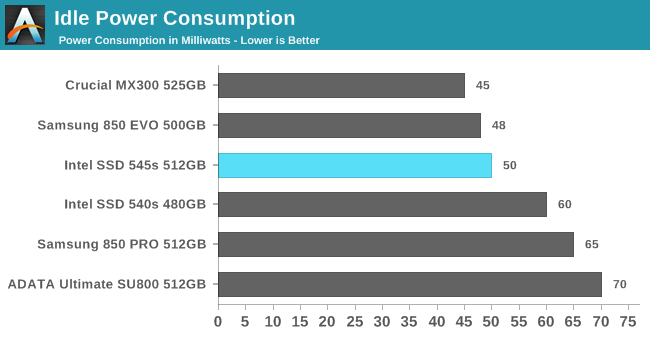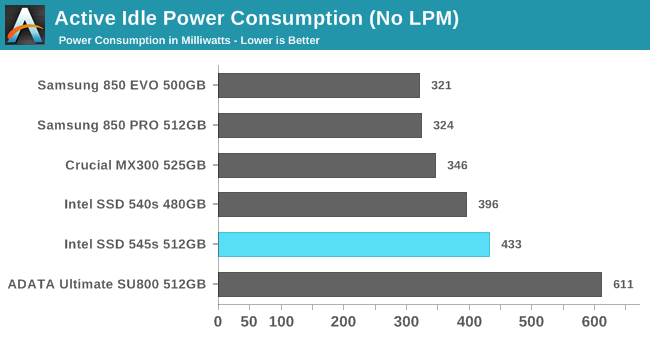The Intel SSD 545s (512GB) Review: 64-Layer 3D TLC NAND Hits Retail
by Billy Tallis on June 27, 2017 6:00 AM ESTIdle Power Consumption
Since the ATSB tests based on real-world usage cut idle times short to 25ms, their power consumption scores paint an inaccurate picture of the relative suitability of drives for mobile use. During real-world client use, a solid state drive will spend far more time idle than actively processing commands. Our SYSmark 2014 SE test covers this case, but because our testbed is a desktop system the SSD's contribution to the total power usage is small and hard to isolate from ordinary variation between test runs.
Our testbed doesn't support the deepest DevSlp power saving mode that SATA drives can implement, but we can measure the power usage in the intermediate slumber state where both the host and device ends of the SATA link enter a low-power state and the drive is free to engage its internal power savings measures.
We also report the drive's idle power consumption while the SATA link is active and not in any power saving state. Drives are required to be able to wake from the slumber state in under 10 milliseconds, but that still leaves plenty of room for them to add latency to a burst of I/O. Because of this, many desktops default to either not using SATA Aggressive Link Power Management (ALPM) at all or to only enable it partially without making use of the device-initiated power management (DIPM) capability. Additionally, SATA Hot-Swap is incompatible with the use of DIPM, so our SSD testbed usually has DIPM turned off during performance testing.

With SATA device-initiated link power management enabled, typical idle power consumption drops by a factor of ten, straining the resolution of our power meter. All of these SATA SSDs have very effective low-power idle states, but the 545s does show clear improvement over the 540s and Intel is now quite close to the Crucial MX300 and Samsung 850 EVO.

The Samsung drives have the best active idle power levels of this bunch, and the Crucial MX300 is not far behind. The Silicon Motion-based Intel 540s, 545s and ADATA SU800 are worst, though only the SU800 is trailing by a large margin. The 545s does draw more power than the 540s, which is not what we would expect from an updated controller design.
Idle Wake-Up Latency
Idle power consumption is not the only important metric of a SSD's power management capabilities. Devices cannot transition in and out of low-power states instantly. It takes time for components to switch back to higher clock speeds and resynchronize their data links to the rest of the system. At the extreme end, the several seconds it takes a hard drive to spin up obviously has a major impact on system responsiveness, and consequently operating systems have to be very conservative about when to put a hard drive to sleep, typically requiring at least several minutes of idle time during which the hard drive is wasting power.
The idle power transition time of solid state drives exists on a very different time scale, but it still matters to systems that are trying to minimize power consumption without sacrificing too much performance. When a SSD only takes a few milliseconds to enter and leave a power saving state, those power saving states can be used far more often, even during sustained interactive use like gaming. The cost of this approach is that far more I/O operations will incur the wake-up latency penalty.
Our equipment is not able to measure how long it takes a SSD to enter a low-power state; this would require very precise synchronization between the CPU and a high-resolution power meter. Timing how long a SSD takes to leave a low-power state is simple: perform one read operation every few seconds, and compare the latency with and without power management enabled. The difference, reported below, includes time taken to reestablish the SATA link and for the SSD to wake up, but does not include the time spent actively reading data from the flash memory since that will be the same whether or not the SSD had just been in a low-power state. Thus, this test is mostly a measure of the SSD controller and its firmware.

The Crucial MX300 has pretty good power consumption both at idle and under load, but its Marvell controller takes far longer to wake up from idle than its competition. At about 3.4ms, the MX300 is almost five times slower to wake up than the ADATA SU800, which has higher idle power consumption. The Intel 545s is a bit on the slow side at 1.4ms, about twice the wake-up latency of the ADATA SU800 or the Intel 540s. The total read latency for the 545s with power management enabled is just over 2.2ms.










74 Comments
View All Comments
jjj - Tuesday, June 27, 2017 - link
Thanks for the details.Guess with this launch, we'll soon have confirmation that they are using string stacking.
jjj - Wednesday, June 28, 2017 - link
Seen this? https://www.wdc.com/about-wd/newsroom/press-room/2...Flashguru - Saturday, July 8, 2017 - link
So you had the Toshiba NVMe 64layer drive first but bumped it from your testing so you could announce Intel was first to market?JimmiG - Tuesday, June 27, 2017 - link
Great to see some competition for the 850 Evo. Kind of ironic that it should come from Intel, who aren't usually known as the underdogs that provide much needed competition...jimjamjamie - Tuesday, June 27, 2017 - link
"On some tests, the Intel 545s appears to be the first serious challenger to the Samsung 850 EVO's combination of high performance and good power efficiency in a TLC SATA SSD."Well now I'm interested. Fingers crossed for decent pricing.
MajGenRelativity - Tuesday, June 27, 2017 - link
Definitely, if it can come under the 850 Evo, I'll have my eye on this drive.halcyon - Tuesday, June 27, 2017 - link
Oh Intel, how far have you fallen. You used to be the innovator, the forerunner.Now you're playing catch up and barely managing at that.
What happened?
jimjamjamie - Wednesday, June 28, 2017 - link
They realised it was more profitable to sell tiny dual and quad core CPUs for hundreds of dollars, add a pin to the socket every few years to sell a new chipset, and add 100MHz to the top end model and sell it for an extra thousand dollars.Retycint - Monday, July 3, 2017 - link
And add four extra cores for more than twice the price of the original. The X series of CPUs and chipsets were completely scams, up until Ryzen happened.Rictorhell - Tuesday, June 27, 2017 - link
Any idea, at all, on what form factors the m.2 versions will be available in, at launch, or the possible capacities that will be available for those form factors?